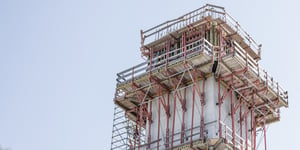
Challenges in Massive Concrete Components: Why Temperature Monitoring is Crucial
Concrete is an extremely versatile building material used in a wide range of construction projects, from small foundations to massive structures such as bridges, tunnels, and dams. However, when it comes to the production of massive concrete components there are special challenges that must be considered. One of the most important is temperature monitoring during concreting. This blog post highlights the special features of massive concrete components and explains why temperature monitoring is so crucial.
What are massive components?
Massive components are concrete structures or elements, generally components with a smallest dimension of > 0.80 m, which due to their size and volume require special thermal management. Examples include large foundation slabs, thick walls, retaining walls, or dams. Their considerable thickness leads to slow heat dissipation, and in turn, can promote thermal stresses and cracking during hydration and curing.
Heat development during concreting – the challenge
Concrete releases heat during hydration, the chemical reaction between cement and water. This heat development is particularly relevant for massive components, as the large amount of concrete stores the heat generated and only releases it into the environment slowly. This leads to a significant temperature rise inside the concrete, while the outer layers can cool down faster. The resulting temperature differential can lead to internal stresses that, in the worst case, can cause cracks that impair the load-bearing capacity and durability of the component.
Why is temperature monitoring important?
Temperature monitoring is crucial to ensure that temperature differences within the component can be managed effectively, and remain within acceptable limits. The temperature must be in the correct range for hydration reaction to occur, while temperature differentials remain minimal. Through careful temperature monitoring, informed decisions and countermeasures can be taken early, such as adjusting the concrete mix, controlling the concreting speed, or using cooling methods.
Methods of temperature monitoring
There are various methods for monitoring the temperature in massive concrete components:
- Temperature measurement of fresh concrete before concreting: This can be done with a digital thermometer or special concrete thermometers that are immersed directly in the concrete mix.
- Temperature measurement in the concrete component during hardening with a thermometer and data logger: Thermoelements, such as TEMO sensors, are placed at various points in the concrete to continuously measure the temperature during hydration. Measuring devices/data loggers record the temperature over a longer period of time, allowing an accurate analysis of the temperature profile. Temperature differences from the core to the outer layers can be documented and analyzed.
- Temperature measurement on the component surface during hardening with infrared thermography: With this method, the surface temperature of the concrete can be recorded without contact, which is useful for identifying local hot spots.
- Core drilling after hardening and subsequent analysis: In some cases, samples are taken to analyze the internal temperatures retrospectively.
Temperature measurement during the hardening of concrete
When producing massive concrete components, monitoring the temperature during hardening is an essential factor in ensuring the quality and durability of the structure. Concrete experts expressly recommend carrying out temperature measurements to monitor the temperature differences between the component core and the surface. Established standards and guidelines, such as ACI, EC, DAFSTB, ZTV-Ing or DIN 1045 Part 2 etc., also recommend or even prescribe temperature measurements.
Through targeted temperature measurement, the development of heating and cooling in the concrete can be controlled and regulated. This allows timely measures to be taken to avoid harmful temperature differences. A common measurement method is with thermocouples, which allow timely measures to be taken to avoid harmful temperature differences. The TEMO system offered by Vemaventuri delivers continuous monitoring providing a detailed picture of the temperature profile within the component.
This provides a detailed picture of the temperature profile in the component. The temperature measurement should be installed at several points within the component to capture both the maximum temperature in the core and the temperatures on the surface. This makes it possible to monitor the differences between these points and react accordingly. The aim is to keep the temperature differences as small as possible, ideally below 20 °C, to minimize the risk of cracking.
Measures for temperature control
To minimize thermal stresses and the risk of cracking, various measures can be taken before and after the concrete is placed:
- Cooling of the concrete: Especially at hot ambient temperatures or with very massive components, the addition of ice water or liquid nitrogen can help to lower the fresh concrete temperature.
- Slow concreting: By means of controlling the concrete speed, to better manage the heat development.
- Optimization of the concrete mix: The use of cements with lower heat of hydration or the addition of admixtures can reduce heat development.
- Aftertreatment of the concrete: Covering the concrete with insulating materials to slow down external cooling, or spraying with water to increase heat dissipation and thus minimize temperature differences.
- Active heating or cooling: Use of heated formwork or the inclusion of internal water cooling systems is also conceivable for extreme or challenging project requirements.
Conclusion
Massive concrete components place special demands on construction practice, particularly with regard to temperature management during concreting. Through careful planning and monitoring, the risk of cracking and thermal stresses can be minimized, ultimately contributing to the durability and safety of the structures. Temperature measurement during hardening plays a key role and should be carried out conscientiously according to the recommendations of experts. Temperature monitoring plays a key role in concrete placement, hardening and maturity and should be carefully considered in order to effectively deliver high quality concrete assets.
Curious about temperature monitoring?
We will present the Vemaventuri solution to you in a 20-minute online demo without any obligation.

